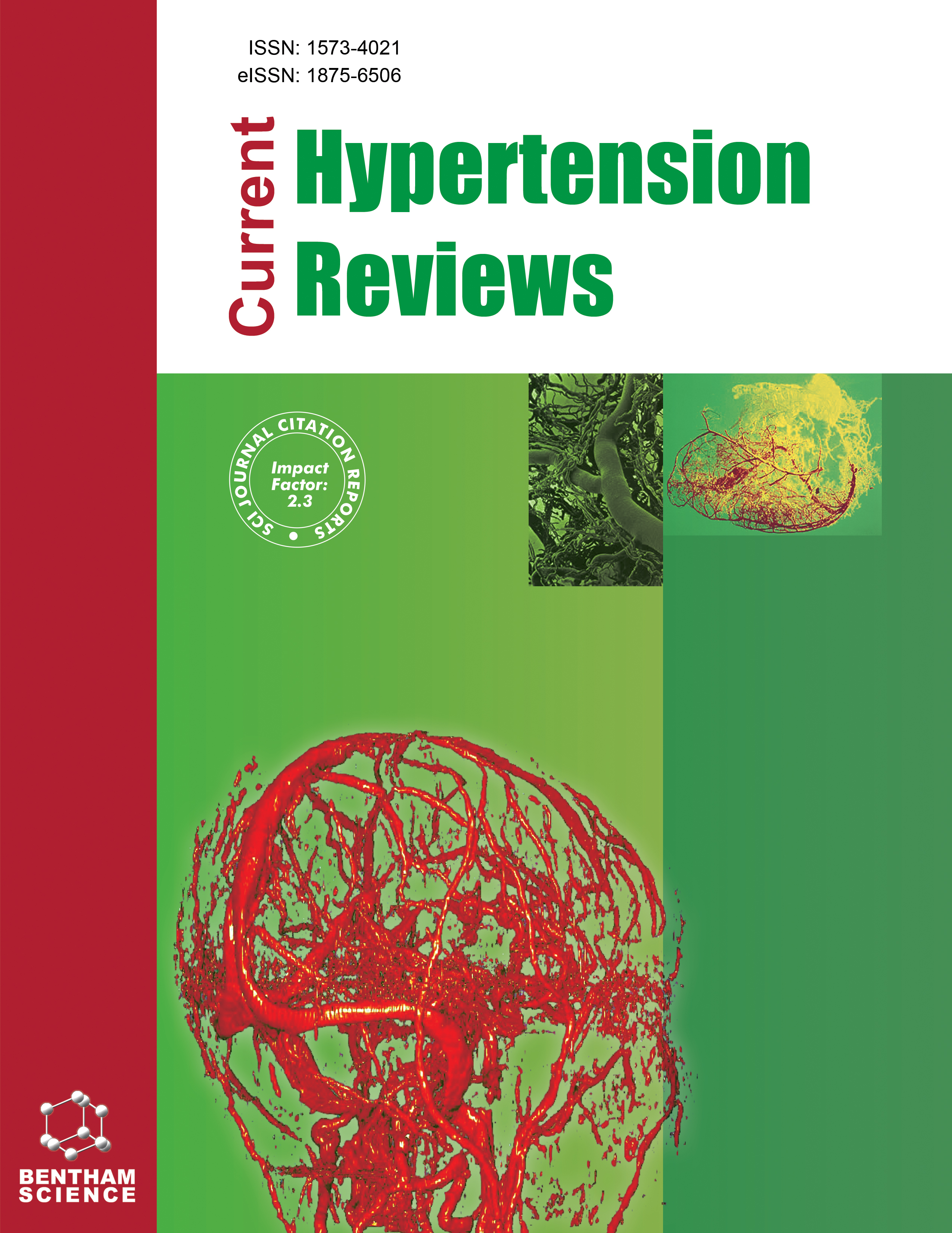- Home
- A-Z Publications
- Current Hypertension Reviews
- Previous Issues
- Volume 5, Issue 2, 2009
Current Hypertension Reviews - Volume 5, Issue 2, 2009
Volume 5, Issue 2, 2009
-
-
Are there Differences in Stroke Prevention with Different Blood Pressure Lowering Agents?
More LessAuthors: Maurizio Paciaroni and Julien BogousslavskyHypertension is the major modifiable risk factor for fatal, nonfatal strokes and other vascular diseases. In a pooled analysis of 61 prospective studies including about one million individuals, the reported risk of stroke increased progressively with blood pressure from values as low as 115/75 mm/Hg. Each increment of 20/10 mm/Hg doubles the risk of cardiovascular disease and such a correlation is consistent at all ages. Bloo Read More
-
-
-
Renovascular Hypertension: Lesion Detection, Patient Selection, Treatment Options and Results
More LessAuthors: Jonathan Deitch, Handel Robinson, Jeffrey Kirk and Nicole SorrentinoRenal artery stenosis (RAS) causing either renovascular hypertension (RVH) or ischemic nephropathy (IN) is a complicated pathophysiologic entity. The diagnosis may remain uncertain in many cases and is frequently obscured by other overlapping sources of hypertension. Improved sensitivities of non-invasive diagnostic imaging modalities has led to an increase in the detection of RAS without necessarily guiding treatment reco Read More
-
-
-
Family History and Preclinical Atherosclerosis
More LessAuthors: Silvia Barra, Mario Caprile, Alfredo Madrid and Giovanni GaetaAtherosclerosis is an inflammatory disease which begins in the first decade of life. As clinically apparent atherosclerosis occurs in adulthood, there is a very long time-interval in which arterial wall abnormalities constitute asymptomatic or “preclinical” atherosclerosis. High-resolution B-mode ultrasound constitutes a valid, reliable and inexpensive method for detecting early both structural and functional atherosclerotic change Read More
-
-
-
24-Hour Blood Pressure Control - A Predictor for Clinical Outcomes
More LessAuthors: Kazuomi Kario, Adam Lowy, Veronica C. Munk and Lieven AnnemansAlthough many studies have addressed the relevance of assessing blood pressure (BP) control over a 24-hour period, it is still an area of dispute among clinicians. There is no clear agreement as to which 24-hour parameters are most important and no standardized definitions. Different types of 24-hour measurement have different implications for outcomes and, differ in their impact on the health economics of hypertension. F Read More
-
-
-
The Role of TNFSF15 in the Modulation of Neovascularization and Inflammation
More LessAuthors: Fang Tian, Sammy Grimaldo and Lu-Yuan LiTumor necrosis factor super family 15 (TNFSF15) is one of the more recently identified TNF ligands. Emerging studies are beginning to reveal the function of TNFSF15 in physiology and pathology. TNFSF15 has been found to have a prominent role in endothelial cell biology. The abundance of TNFSF15 in the vasculature suggests that the endothelium be the major production site of this cytokine. TNFSF15 has been shown to be Read More
-
-
-
Dissections of the Thoracic Aorta and Evolving Endovascular Strategies
More LessAuthors: Tahir Ali, David Sayers, Lukha Biasi, Rob Morgan, Ian Loftus and Matt ThompsonAcute dissection is the most common life threatening condition of the aorta affecting 5-30 per million people per year [1]. Left untreated, the majority of patients with dissections involving the ascending aorta will die within days of an acute episode [2]. Patients presenting with descending thoracic aortic dissections seem to fare better, with one in ten patients dying before leaving hospital. Ultimately, these patients are at ris Read More
-
-
-
Static Cerebral Blood Flow Autoregulation in Humans
More LessAuthors: Ronan M.G. Berg, Michael Pedersen and Kirsten MollerStatic cerebral blood flow (CBF) autoregulation maintains a constant CBF despite changes in cerebral perfusion pressure (CPP) within certain limits; this is achieved through adaptive responses in the cerebrovascular resistance, i.e. arteriolar vasoconstriction and vasodilation. This system may protect the brain from hyper- and hypoperfusion upon CPP challenges. CBF autoregulation appears to be mediated through myogenic a Read More
-
-
-
Hyperhomocysteinemia and Endothelial Dysfunction
More LessAuthors: Zhong-Jian Cheng, Xiaofeng Yang and Hong WangHyperhomocysteinemia (HHcy) is a significant and independent risk factor for cardiovascular diseases. Endothelial dysfunction (ED) is the earliest indicator of atherosclerosis and vascular diseases. We and others have shown that HHcy induced ED in human and in animal models of HHcy induced by either high-methionine load or genetic deficiency. Six mechanisms have been suggested explaining HHcy-induced ED. These Read More
-
Volumes & issues
-
Volume 21 (2025)
-
Volume 20 (2024)
-
Volume 19 (2023)
-
Volume 18 (2022)
-
Volume 17 (2021)
-
Volume 16 (2020)
-
Volume 15 (2019)
-
Volume 14 (2018)
-
Volume 13 (2017)
-
Volume 12 (2016)
-
Volume 11 (2015)
-
Volume 10 (2014)
-
Volume 9 (2013)
-
Volume 8 (2012)
-
Volume 7 (2011)
-
Volume 6 (2010)
-
Volume 5 (2009)
-
Volume 4 (2008)
-
Volume 3 (2007)
-
Volume 2 (2006)
-
Volume 1 (2005)
Most Read This Month
Article
content/journals/chyr
Journal
10
5
false
en


